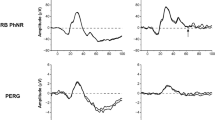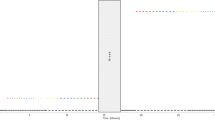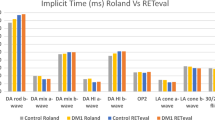Abstract
Purpose
Several methods are routinely used in the clinic to diagnose and monitor diseases of inner retinal function. In this study, we compare four such methods in patients with diabetes and glaucoma, to determine correlations between their results and to determine which method is most sensitive for detecting disease.
Methods
Twenty control subjects, 12 patients with early glaucoma and eight patients with diabetes mellitus, were enrolled in the study. All underwent four examinations: transient pattern electroretinogram (PERG), multifocal pattern electroretinogram (mfPERG), chromatic contrast threshold measurements (protan and tritan), and blue-on-yellow short-wavelength automated perimetry (SWAP).
Results
For the total cohort of 40 subjects, the results show a significant correlation between the amplitudes of the PERG and those of the mfPERG, as well as between the tritan contrast thresholds and the SWAP MD. Furthermore, ROC analyses reveal that colour contrast thresholds could significantly distinguish between the patient and the control group. Glaucoma patients alone could also be distinguished.
Conclusions
We conclude that the methods compared in this study show correlations between their results if they are testing same pathway or underling cells, and that the colour contrast threshold is the most sensitive method to detect early functional deficits in diabetic and glaucoma patients.






Similar content being viewed by others
References
Francois J, Verriest G (1959) Acquired dyschromatopsia in primary glaucoma. Ann Ocul 192(3):191–199
Kinnear PR, Aspinall PA, Lakowski R (1972) The diabetic eye and colour vision. Trans Opthalmol Soc UK 92:69–78
Greenstein V, Sarter B, Hood D, Noble K, Carr R (1990) Hue discrimination and S cone pathway sensitivity in early diabetic retinopathy. Invest Ophthalmol Vis Sci 31:1008–1014
Kurtenbach A, Wagner U, Neu A, Schiefer U, Ranke MB, Zrenner E (1994) Brightness matching and colour discrimination in young diabetics without retinopathy. Vis Res 34:115–122
Polo V, Larrosa JM, Pinilla I, Gonzalvo F, Ferreras A, Honrubia FM (2002) Glaucomatous damage patterns by short-wavelength automated perimetry (SWAP) in glaucoma suspects. Eur J Ophthalmol 12(1):49–54
Remky A, Weber A, Hendricks S, Lichtenberg K, Arend O (2003) Short-wavelength automated perimetry in patients with diabetes mellitus without macular edema. Graefes Arch Clin Exp Ophthalmol 241(6):468–471. doi:10.1007/s00417-003-0666-0
Han Y, Adams AJ, Bearse MA Jr, Schneck ME (2004) Multifocal electroretinogram and short-wavelength automated perimetry measures in diabetic eyes with little or no retinopathy. Arch Ophthalmol 122(12):1809–1815. doi:10.1001/archopht.122.12.1809
Sample PA, Weinreb RN (1990) Color perimetry for assessment of primary open-angle glaucoma. Invest Ophthalmol Vis Sci 31(9):1869–1875
Holder GE (2001) The pattern electroretinogram. In: Fishman GA, Birch DG, Holder GE, Brigell MG (eds) Electrophysiologic testing in disorders of the retina, optic nerve and visual pathway. American Academy of Ophthalmology Series, 2nd edn. Oxford University Press, San Francisco, pp 197–235
Bach M, Hoffmann MB (2008) Update on the pattern electroretinogram in glaucoma. Optom Vis Sci 85(6):386–395
Klistorner AI, Graham SL, Martins A (2000) Multifocal pattern electroretinogram does not demonstrate localized field defects in glaucoma. Doc Ophthalmol 1090:155–166
Bach M, Brigell MG, Hawlina M, Holder GE, Johnson MA, McCulloch DL, Meigen T, Viswanathan S (2013) ISCEV standard for clinical pattern electroretinography (PERG): 2012 update. Doc Ophthalmol. doi:10.1007/s10633-012-9353-y
Langrova H, Jagle H, Zrenner E, Kurtenbach A (2007) The multifocal pattern electroretinogram (mfPERG) and cone-isolating stimuli. Vis Neurosci 24(6):805–816
Arden GB, Gündüz K, Perry S (1988) Colour vision testing with a computer graphics system. Clin Vis Sci 2(4):303–320
Berninger T, Drobner B, Hogg C, Rudolph G, Arden GB, Kampik A (1999) Color vision in relation to age: a study of normal values. Klin Monbl Augenheilkd 215(1):37–42
Wright CE, Williams DE, Drasdo N, Harding GF (1985) The influence of age on the electroretinogram and visual evoked potential. Doc Ophthalmol 59(4):365–384
Hull BM, Drasdo N (1990) The influence of age on the pattern-reversal electroretinogram. Ophthalmic Physiol Opt 10(1):49–53
Johnson CA, Adams AA, Twelker JD, Quigg JM (1988) Age-related changes in the central visual field for short-wavelength-sensitive pathways. J Opt Soc Am A 5(12):2131–2139
Gaffney AJ, Binns AM, Margrain TH (2012) Aging and cone dark adaptation. Optom Vis Sci 89(8):1219–1224. doi:10.1097/OPX.0b013e318263c6b1
Gray LS, Heron G, Cassidy D, Clark GM, Cowley GR, Gourlay DM, Ross FM (1995) Comparison of age-related changes in short-wavelength-sensitive cone thresholds between normals and patients with primary open-angle glaucoma. Optom Vis Sci 72:205–209
Ruben ST, Arden GB, O’Sullivan F, Hitchings RA (1995) Pattern electroretinogram and peripheral colour contrast thresholds in ocular hypertension and glaucoma: comparison and correlation of results. Br J Ophthalmol 79(4):326–331
Harrison WW, Viswanathan S, Malinovsky VE (2006) Multifocal pattern electroretinogram: cellular origins and clinical implications. Optom Vis Sci 83(7):473–485
Bach M, Sulimma F, Gerling J (1997) Little correlation of the pattern electroretinogram (PERG) and visual field measures in early glaucoma. Doc Ophthalmol 94(3):253–263
Tafreshi A, Racette L, Weinreb RN, Sample PA, Zangwill LM, Medeiros FA, Bowd C (2010) Pattern electroretinogram and psychophysical tests of visual function for discriminating between healthy and glaucoma eyes. American Journal of Ophthalmology 149(1879–1891 (Electronic)):488–495
Caputo S, Di Leo MA, Falsini B, Ghirlanda G, Porciatti V, Minella A, Greco AV (1990) Evidence for early impairment of macular function with pattern ERG in type I diabetic patients. Diabetes Care 13(4):412–418
Falsini B, Marangoni D, Salgarello T, Stifano G, Montrone L, Campagna F, Aliberti S, Balestrazzi E, Colotto A (2008) Structure-function relationship in ocular hypertension and glaucoma: interindividual and interocular analysis by OCT and pattern ERG. Graefes Arch Clin Exp Ophthalmol 246(8):1153–1162. doi:10.1007/s00417-008-0808-5
Taliantzis S, Papaconstantinou D, Koutsandrea C, Moschos M, Apostolopoulos M, Georgopoulos G (2009) Comparative studies of RNFL thickness measured by OCT with global index of visual fields in patients with ocular hypertension and early open angle glaucoma. Clin Ophthalmol 3:373–379
Ciresi A, Amato MC, Morreale D, Morreale R, Di Giovanna F, Carità S, Lodato G, Galluzzo A, Giordano C (2010) OCT is not useful for detection of minimal diabetic retinopathy in type 1 diabetes. Acta Diabetol 47:259–263
Acknowledgments
The German Academic Exchange Service provided funding in the form of grant funding to HL. The sponsor had no role in the design or conduct of this research.
Author information
Authors and Affiliations
Corresponding author
Ethics declarations
Conflict of interest
All authors certify that they have no affiliations with or involvement in any organisation or entity with any financial interest (such as honoraria; educational grants; participation in speakers’ bureaus; membership, employment, consultancies, stock ownership, or other equity interest; and expert testimony or patent-licensing arrangements), or non-financial interest (such as personal or professional relationships, affiliations, knowledge or beliefs) in the subject matter or materials discussed in this manuscript.
Statements of human rights
All procedures performed in studies involving human participants were in accordance with the ethical standards of the institutional and/or national research committee and with the 1964 Declaration of Helsinki and its later amendments or comparable ethical standards.
Statement on the welfare of animals
This article does not contain any studies with animals performed by any of the authors.
Informed consent
Informed consent was obtained from all individual participants included in the study.
Rights and permissions
About this article
Cite this article
Kurtenbach, A., Kernstock, C., Zrenner, E. et al. Electrophysiology and colour: a comparison of methods to evaluate inner retinal function. Doc Ophthalmol 131, 159–167 (2015). https://doi.org/10.1007/s10633-015-9512-z
Received:
Accepted:
Published:
Issue Date:
DOI: https://doi.org/10.1007/s10633-015-9512-z




